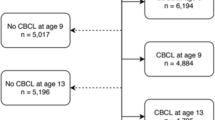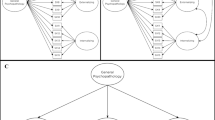Abstract
The general factor of psychopathology (GP, or p factor) and the Dysregulation Profile (DP) are two conceptually similar, but independently developed approaches to understand psychopathology. GP and DP models and their stability, antecedents and outcomes are studied in a longitudinal sample of 1073 children (49.8% female). GP and DP models were estimated at ages 8 and 14 years using the parent-reported Child Behavior Checklist (CBCL) and Youth Self Report (YSR). Early childhood antecedents and adolescent outcomes were derived using a multi-method multi-informant approach. Results showed that the general GP and DP had similar key symptoms and were similarly related to early-childhood antecedents (e.g., lower effortful control, higher maternal depression) and adolescent outcomes (e.g., reduced academic functioning, poorer mental health). This study demonstrates that GP and DP are highly similar constructs in middle childhood and adolescence, both describing a general vulnerability for psychopathology with (emotional) dysregulation at its core. Scientific integration of these approaches could lead to a better understanding of the structure, antecedents and outcomes of psychopathology.

Similar content being viewed by others
References
Achenbach TM, Ivanova MY, Rescorla LA, Turner LV, Althoff RR (2016) Internalizing/externalizing problems: review and recommendations for clinical and research applications. J Am Acad Child Adolesc Psychiatry 55(8):647–656
Patalay P, Moulton V, Goodman A, Ploubidis GB (2017) Cross-domain symptom development typologies and their antecedents: results from the UK Millennium Cohort Study. J Am Acad Child Adolesc Psychiatry 56(9):765–776
Rhee SH, Lahey BB, Waldman ID (2015) Comorbidity among dimensions of childhood psychopathology: converging evidence from behavior genetics. Child Dev Perspect 9(1):26–31
Caspi A et al (2014) The p factor: one general psychopathology factor in the structure of psychiatric disorders? Clin Psychol Sci 2(2):119–137
Lahey BB et al (2012) Is there a general factor of prevalent psychopathology during adulthood? J Abnorm Psychol 121(4):971–977
Geeraerts SB et al (2015) The child behavior checklist dysregulation profile in preschool children: a broad dysregulation syndrome. J Am Acad Child Adolesc Psychiatry 54(7):595–602
Deutz MHF, Geeraerts SB, van Baar AL, Deković M, Prinzie P (2016) The dysregulation profile in middle childhood and adolescence across reporters: factor structure, measurement invariance, and links with self-harm and suicidal ideation. Eur Child Adolesc Psychiatry 25(4):431–442
Haltigan JD et al (2018) “P” and “DP:” examining symptom-level bifactor models of psychopathology and dysregulation in clinically referred children and adolescents. J Am Acad Child Adolesc Psychiatry 57(6):384–396
Laceulle OM, Vollebergh WAM, Ormel J (2015) The structure of psychopathology in adolescence. Clin Psychol Sci 3(6):850–860
Olino TM, Dougherty LR, Bufferd SJ, Carlson GA, Klein DN (2014) Testing models of psychopathology in preschool-aged children using a structured interview-based assessment. J Abnorm Child Psychol 42(7):1201–1211
Patalay P et al (2015) A general psychopathology factor in early adolescence. Br J Psychiatry 207(1):15–22
Tackett JL et al (2013) Common genetic influences on negative emotionality and a general psychopathology factor in childhood and adolescence. J Abnorm Psychol 122(4):1142–1153
Biederman J et al (1995) CBCL clinical scales discriminate prepubertal children with structured interview—derived diagnosis of mania from those with ADHD. J Am Acad Child Adolesc Psychiatry 34(4):464–471
Diler RS et al (2009) The Child Behavior Checklist (CBCL) and the CBCL-bipolar phenotype are not useful in diagnosing pediatric bipolar disorder. J Child Adolesc Psychopharmacol 19(1):23–30
Holtmann M, Goth K, Wockel L, Poustka F, Bolte S (2008) CBCL-pediatric bipolar disorder phenotype: severe ADHD or bipolar disorder? J Neural Transm 115(2):155–161
Althoff RR, Verhulst FC, Rettew DC, Hudziak JJ, van der Ende J (2010) Adult outcomes of childhood dysregulation: a 14-year follow-up study. J Am Acad Child Adolesc Psychiatry 49(11):1105–1116
McElroy E, Belsky J, Carragher N, Fearon P, Patalay P (2018) Developmental stability of general and specific factors of psychopathology from early childhood to adolescence: dynamic mutualism or p-differentiation? J Child Psychol Psychiatry 59(6):667–675
Olino TM et al (2018) The development of latent dimensions of psychopathology across early childhood: stability of dimensions and moderators of change. J Abnorm Child Psychol 46(7):1373–1383
Deutz MHF et al (2018) Evaluation of the strengths and difficulties questionnaire-dysregulation profile (SDQ-DP). Psychol Assess 30(9):1174
Boomsma DI et al (2006) Longitudinal stability of the CBCL-juvenile bipolar disorder phenotype: a study in Dutch twins. Biol Psychiatry 60(9):912–920
Lahey BB et al (2015) Criterion validity of the general factor of psychopathology in a prospective study of girls. J Child Psychol Psychiatry 56(4):415–422
Bonifay W, Lane SP, Reise SP (2017) Three concerns with applying a bifactor model as a structure of psychopathology. Clin Psychol Sci 5(1):184–186
Snyder HR, Hankin BL (2017) All models are wrong, but the p factor model is useful: reply to Widiger and Oltmanns (2017) and Bonifay, Lane, and Reise (2017). Clin Psychol Sci 5(1):187–189
Tackett JL et al (2013) Common genetic influences on negative emotionality and a general psychopathology factor in childhood and adolescence. J Abnorm Psychol 122(4):1142
Hankin BL et al (2017) Temperament factors and dimensional, latent bifactor models of child psychopathology: transdiagnostic and specific associations in two youth samples. Psychiatry Res 252:139–146
Neumann A et al (2016) Single nucleotide polymorphism heritability of a general psychopathology factor in children. J Am Acad Child Adolesc Psychiatry 55(12):1038–1045
Carver CS, Johnson SL, Timpano KR (2017) Toward a functional view of the p factor in psychopathology. Clin Psychol Sci 5(5):880–889
Snyder HR, Young JF, Hankin BL (2017) Strong homotypic continuity in common psychopathology-, internalizing-, and externalizing-specific factors over time in adolescents. Clin Psychol Sci 5(1):98–110
Achenbach TM, Rescorla LA (2001) Manual for the ASEBA school-age forms & profiles. University of Vermont, Research Center for Children, Youth, & Families, Burlington
Muthén LK, Muthén BO (2012) Mplus Version 7 user’s guide. Muthén & Muthén, Los Angeles
Lt Hu, Bentler PM (1999) Cutoff criteria for fit indexes in covariance structure analysis: conventional criteria versus new alternatives. Struct Equ Model 6(1):1–55
Cheung GW, Rensvold RB (2002) Evaluating goodness-of-fit indexes for testing measurement invariance. Struct Equ Model 9(2):233–255
Castellanos-Ryan N et al (2016) The structure of psychopathology in adolescence and its common personality and cognitive correlates. J Abnorm Psychol 125(8):1039–1052
Caspi A, Moffitt TE (2018) All for one and one for all: mental disorders in one dimension. Am J Psychiatry 17(5):831–844
Sheppes G, Suri G, Gross JJ (2015) Emotion regulation and psychopathology. Annu Rev Clin Psychol 11:379–405
Masi G, Muratori P, Manfredi A, Pisano S, Milone A (2015) Child behaviour checklist emotional dysregulation profiles in youth with disruptive behaviour disorders: clinical correlates and treatment implications. Psychiatry Res 225(1–2):191–196
Stringaris A, Zavos H, Leibenluft E, Maughan B, Eley TC (2012) Adolescent irritability: phenotypic associations and genetic links with depressed mood. Am J Psychiatry 169(1):47–54
Murray AL, Eisner M, Ribeaud D (2016) The development of the general factor of psychopathology ‘p factor’ through childhood and adolescence. J Abnorm Child Psychol 44(8):1573–1586
Deutz MHF et al (2018) Normative development of the child behavior checklist dysregulation profile from early childhood to adolescence: associations with personality pathology. Dev Psychopathol 30(2):437–447
Greene AL, Eaton NR (2017) The temporal stability of the bifactor model of comorbidity: an examination of moderated continuity pathways. Compr Psychiatry 72:74–82
DeLisi M, Vaughn MG (2014) Foundation for a temperament-based theory of antisocial behavior and criminal justice system involvement. J Crim Justice 42:10–25
DeLisi M, Fox BH, Fully M, Vaughn MG (2018) The effects of temperament, psychopathy, and childhood trauma among delinquent youth: a test of DeLisi and Vaughn’s temperament-based theory of crime. Int J Law Psychiatry 57:53–60
Winsper C, Wolke D (2014) Infant and toddler crying, sleeping and feeding problems and trajectories of dysregulated behavior across childhood. J Abnorm Child Psychol 42:831–843
Althoff RR et al (2012) Temperamental profiles of dysregulated children. Child Psychiatry Hum Dev 43:511–522
Bloemen A et al (2018) The association between executive functioning and psychopathology: general or specific? Psychol Med 48(11):1787–1794
Martel MM et al (2017) A general psychopathology factor (P factor) in children: structural model analysis and external validation through familial risk and child global executive function. J Abnorm Psychol 126(1):137–148
Ein-Dor T, Viglin D, Doron G (2016) Extending the transdiagnostic model of attachment and psychopathology. Front Psychol 7:484
Johnston DW, Propper C, Pudney SE, Shields MA (2014) The income gradient in childhood mental health: all in the eye of the beholder? J R Stat Soc 177(4):807–827
Patalay P, Fitzsimons E (2016) Correlates of mental illness and wellbeing in children: are they the same? Results from the UK Millennium Cohort Study. J Am Acad Child Adolesc Psychiatry 55(9):771–783
Rescorla LA et al (2013) Cross-informant agreement between parent-reported and adolescent self-reported problems in 25 societies. J Clin Child Adolesc Psychol 42(2):262–273
Hyde LW, Shaw DS, Harri AR (2013) Understanding youth antisocial behavior using neuroscience through a developmental psychopathology lens: review, integration and directions for research. Biol Psychiatry 58:562568
Pettersson E, Larsson H, Lichtenstein P (2016) Common psychiatric disorders share the same genetic origin: a multivariate sibling study of the Swedish population. Mol Psychiatry 21(5):717
Pettersson E, Anckarsäter H, Gillberg C, Lichtenstein P (2013) Different neurodevelopmental symptoms have a common genetic etiology. J Child Psychol Psychiatry 54(12):1356–1365
Reise SP (2012) The rediscovery of bifactor measurement models. Multivar Behav Res 47(5):667–696
Lahey BB, Krueger RF, Rathouz PJ, Waldman ID, Zald DH (2017) A hierarchical causal taxonomy of psychopathology across the life span. Psychol Bull 143(2):142–186
Kotov R et al (2017) The Hierarchical Taxonomy of Psychopathology (HiTOP): a dimensional alternative to traditional nosologies. J Abnorm Psychol 126(4):454–477
Acknowledgements
Sanne Geeraerts is affiliated with the Consortium on Individual Development (CID), which is funded through the Gravitation program of the Dutch Ministry of Education, Culture, and Science and the Netherlands Organization for Scientific Research (NWO Grant Number 024.001.003).
Author information
Authors and Affiliations
Corresponding author
Ethics declarations
Conflict of interest
The authors declare that they have no conflict of interest.
Ethical Approval
All procedures performed in studies involving human participants were in accordance with the ethical standards of the institutional and/or national research committee and with the 1964 Helsinki declaration and its later amendments or comparable ethical standards.
Additional information
Publisher's Note
Springer Nature remains neutral with regard to jurisdictional claims in published maps and institutional affiliations.
Electronic supplementary material
Below is the link to the electronic supplementary material.
Rights and permissions
About this article
Cite this article
Deutz, M.H.F., Geeraerts, S.B., Belsky, J. et al. General Psychopathology and Dysregulation Profile in a Longitudinal Community Sample: Stability, Antecedents and Outcomes. Child Psychiatry Hum Dev 51, 114–126 (2020). https://doi.org/10.1007/s10578-019-00916-2
Published:
Issue Date:
DOI: https://doi.org/10.1007/s10578-019-00916-2




